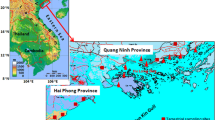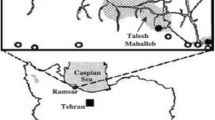Abstract
More than one hundred different food stuffs (meat, vegetables cereals, seafood,..) have been collected during 1998, 1999 and 2000 and analyzed for radioactivity as part of the National Food Monitoring Program in Syria. Results have shown that most of the observed concentrations were within the range of the worldwide values with the exception of relatively high levels of 210Po being observed in fish, vegetables, mushrooms, herbs and flowers. The daily intakes of the radionuclides studied have been evaluated. Relatively high values, in comparison with some countries, were found for 210Po (1.9 Bq/day). This is due to high content of 210Po in wheat (2.3 Bq/kg) consumed by Syrians, the daily consumption of wheat by Syrians is about 526 g. In addition, natural and artificial radionuclides in some manufactured food of Syrian infant and their intake rates have been determined. Seventeen manufactured food and eleven types of canned milk were collected from the local market and their radioactivity analyzed. 210Po activity concentration varied between 0.38 and 2.89 Bq/kg dry wt. in canned milk while the highest concentration in infant food was found to be 1.69 Bq/kg dry wt. Other radionuclide concentrations were below the limit of detection of 3 Bq/kg dry wt. and 4 Bq/kg dry wt. for 226Ra and 228Ra, respectively, while uranium concentration varied between 2.2 and 10.5 µg/kg dry wt. in milk samples and 0.78-6.0 µg/kg dry wt. in other food samples.
Similar content being viewed by others
References
UNSCEAR (United Nations Scientific Committee on the Effect of Atomic Radiation), Sources and Effects of Ionizing Radiation, Report to the General Assembly with Annexes, United Nations, New York, 1988.
S. Chaudhury, M. Boruah, T. D. Goswami, Defense Sci. J., 42 (1992) 242.
E. L. Cooper, E. Zeiller, A. Ghods-Esplahani, M. Makareqcz, R. Schelenez, O. Frindik, M. Aelilgeist, W. Klus, J. Environ. Radioact., 17 (1992) 147.
H. S. Dang, V. R. Pullat, D. D. Jaiswal, M. Paramesmaran, J. Radioanal. Nucl. Chem., 138 (1990) 67.
C. Kuwahara, K. Koyama, J. Sugiyama, J. Radioanal. Nucl. Chem., 220 (1997) 161.
V. E. Noshkin, W. L. Robison, K. M. Wong, Sci. Total Environ., 155 (1994) 87.
Z. Pietrzak-Flis, E. Chrzanowski, S. Dembinska, Sci. Total Environ., 203 (1997) 157.
V. K. Shukla, M. R. Menon, T. V. Ramachandran, A. P. Sathe, S. B. Higorani, J. Environ. Radioact., 28 (1994) 229.
J. L. Smith, J. L. Brigges, E. J. Bradly, Sci. Total Environ., 35 (1984) 431.
M. Yamamoto, K. Shiraihi, K. Komura, K. Ueno, J. Radioanal. Nucl. Chem., 184 (1994) 183.
E. Yunoki, T. Kataoka, K. Michiro, H. Sugiyama, M. Shimizu, T. Mori, J. Radioanal. Nucl. Chem., 174 (1993) 223.
G. Campos, G. Venuti, S. Risica, A. Rpgani, Radiat. Prot. Dosim., 37 (1991) 43.
E. Bosshard, B. Zimmerli, C. Schlatter, Chemosphere, 24 (1992) 309.
S. F. Jerez-Vegueria, I. Frometa-Suaurez, 137Cs in Milk Produced in Lithuania Dose in Infants by Infants, Instituto de Medicina del Trabajo, La Habana, 1997, p. 5.
I. Othman, M. S. Al-Masri, M. Mograbi, K. H. Skhitta, Uranium Levels in Some Syrian Agricultural Products, AECSPR\RSS 223, 1998.
M. S. Al-Masri, S. Mamish, Y. Budier, A. Nashwati, J. Environ. Radioact., 49 (2000) 345.
W. W. Flynn, Anal. Chem., 43 (1968) 221.
R. Tykva, J. Sabal, Low Level Environmental Radioactivity, Sources and Evaluation, Technoic Publishing Inc., Basel, 1995, p. 25.
I. Othman, T. Yassine, Environ. Intern., 22 (1996) 355.
J. Korish, Handbook of Ion Exchange Resins: Their Application to Inorganic Analytical Chemistry, CRC Press, Boca Raton, FL., 1989.
WHO, Derived Intervention Levels for Radionuclides in Food, World Health Organization, Geneva, 1988.
International Atomic Energy Agency (IAEA), Assessment of Doses to the Public from Ingested Radionuclides, Safety Reports Series, No. 14, Vienna, 1999.
J. S. Hughes, M. C. O'Riordan, Radiation Exposure of the UK Population, NRPB, R263, HMSO, London, 1993.
V. E. Noshkin, W. L. Robison, K. M. Wong, Sci. Total Environ., 155 (1999) 87.
UNSCEAR (United Nations Scientific Committee on the Effect of Atomic Radiation), Sources and Effects of Ionizing Radiation, Report to the General Assembly with Annexes, United Nations, New York, 1982.
Author information
Authors and Affiliations
Rights and permissions
About this article
Cite this article
Al-Masri, M.S., Mukallati, H., Al-Hamwi, A. et al. Natural radionuclides in Syrian diet and their daily intake. Journal of Radioanalytical and Nuclear Chemistry 260, 405–412 (2004). https://doi.org/10.1023/B:JRNC.0000027116.84320.33
Issue Date:
DOI: https://doi.org/10.1023/B:JRNC.0000027116.84320.33




